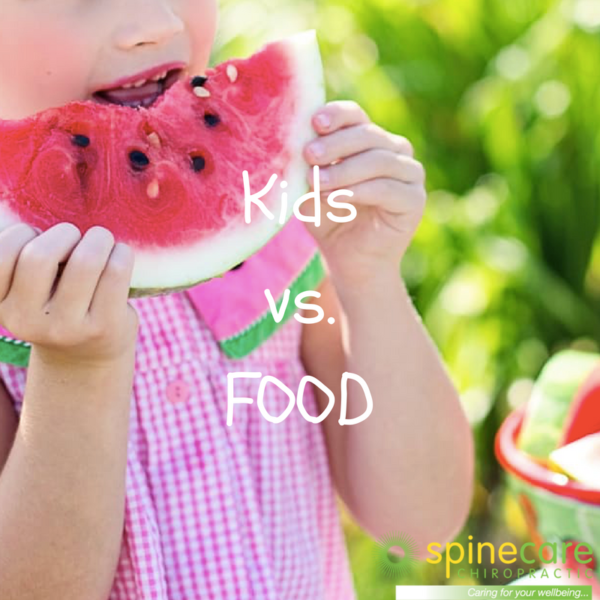Helping Adelaide kids eat healthy! [Creative ways to entice your little people to love good food]

*** Only for February, Spinecare Prospect is offering a brilliant ‘back to school’ special for your kids! Baby and kids initial consults are half price – usually $135; this February $67.50! Call us on 08 8342 3555 to book your little people in, today ***
“I DON’T LIKE IT!” she bellowed, as peas and spinach and pumpkin went flying across the room.
For such small people, kids sure know how to make a BIG fuss about food.
What they do like, what they don’t like, and what deserves to end up on the floor.
If you have finicky eaters in your family, you’ll be familiar with the difficulty of dinnertime – especially if there’s broccoli involved. But instead of fighting, why not try alternative, clever and creative ways of enticing your kids to choose nutritious food (most of the time)?
Here at Spinecare, we’re on a mission to help the kids of Adelaide eat healthier, and feel better for it. Check out our best advice, and let us know your thoughts in the comments!
Why does good nutrition for children matter?

It’s easy to see kids as resilient little robots, racing around, burning calories, and not feeling the effects of bad food.
Unfortunately, a poor diet negatively affects children in a number of ways:
→ Kids who eat diets high in sugar, fat and processed ingredients in early life, have lower IQs by age 8 (Northstone et al., 2011).
→ Kids carry their eating habits with them for life. The earlier they cement good ones, the more likely they are to become health-conscious adults.
→ The risk of big-name diseases such as heart disease, cancer, diabetes and obesity is drastically reduced when kids (and adults) follow a nutritious diet combined with a healthy lifestyle.
→ Studies show that adults who ate better as kids, score higher on intellectual tests – regardless of their schooling (Stein, 2013).
→ Some childhood behavioural and mood disorders may be aggravated by poor food choices and improved by healthier ones.
While it’s clear that feeding your kids good food is important, this doesn’t mean you have to be perfect.
In fact, you’re strictly forbidden to ‘feel like a bad parent’ if your children end up eating icy poles for dinner. It happens, and the only important thing is that you try your best!
What does a nutritious diet for kids look like?
Like a nutritious diet for adults!
While there are certain flavours that tiny tastebuds are averse to, the more your kids simply eat like you do – enjoying a balanced, varied diet – the better (not to mention, meal preparation will become far easier for whoever’s on cooking duty).
Basic principles of good nutrition include; a focus on whole foods, rather than processed. Enjoying a wide variety of vegetables and fruits. Opting for water, not soft drinks or juice. Consuming plenty of proteins, (good) fats and complex carbohydrates.
Kid-friendly foods include: sweet potato, squash and potato, fresh and cooked fruits, beef, chicken and fish, avocado, coconut products and good quality dairy, if they’re not allergic.
Creative ways to encourage your kids to get healthy
✔ Baby steps.
Swap ONE ‘unhealthy’ item out for a healthier option per week (or even fortnight!). Like watered-down juice for soft drink. Or plain gluten-free crackers for chips. There’s no rush. Take it slow, decide on changes as a family, and give everyone time to adjust.
✔ Make smart (and a little bit sneaky) substitutions.
Consider preservative free, ‘real-meat’ hot dogs or sausages, home cooked fish & chips, simple homemade baked treats – without the highly processed ingredients, sugar content and colourings. These substitutions all help your kids feel like they’re getting the ‘naughty’ stuff – without the actual naughty stuff. [Need ideas? We’ve already shared 33 kid-friendly lunch box ideas, plus a winning assortment of healthy cake recipes to get you inspired in the kitchen!]
✔ Have delicious sauces and tasty condiments on hand – like homemade tomato sauce, salsa or guacamole.
Kids love adding extras to meats and vegetables – encouraging them to eat more of the good stuff!
✔ Pretend that you’re making ‘special adult food’ that’s not for them.
You might find your kids begging to try it!
✔ Explain the principles of healthy eating.
Educate and encourage – don’t lecture. Offer your kids cool facts about what happens to food inside their body. Read labels together. Let them come to their own conclusions. (Need advice on nutrition, to pass onto your kids? Ask us next time you’re in clinic!)
✔ Instead of having ‘treats’ in the house – just have ‘food’.
Avoid psychologically connecting certain foods with rewards or good behaviour – it’s better if food is simply seen as sustenance, not something emotionally charged.
✔ Get them cooking!
The more kids are involved in the cooking process, the more likely they are to sample their creation!
✔ Be flexible
‘Banning’ foods entirely may encourage kids to seek them out.
✔ Being a good role model is the best thing you can do.
Even if your kids refuse to so much as nibble on that healthy carrot cake you made them, never underestimate the power of role modelling. Your healthy habits will eventually make sense, sink in and be displayed in your children. In the meantime, simply do the best you can. Your strong, energetic, grown-up kids will thank you in the future!
*** Only for February, Spinecare Prospect is offering a brilliant ‘back to school’ special for your kids! Baby and kids initial consults are half price – usually $135; this February $67.50! Call us on 08 8342 3555 to book your little people in, today! ***
References
Northstone, K., Joinson, C., Emmett, P., Ness, A. and Paus, T. (2011). Are dietary patterns in childhood associated with IQ at 8 years of age? A population-based cohort study. Journal of Epidemiology and Community Health, 66(7), pp.624-628.
Stein, A. (2013). Nutrition in early life and cognitive functioning. American Journal of Clinical Nutrition, 99(1), pp.1-2.

